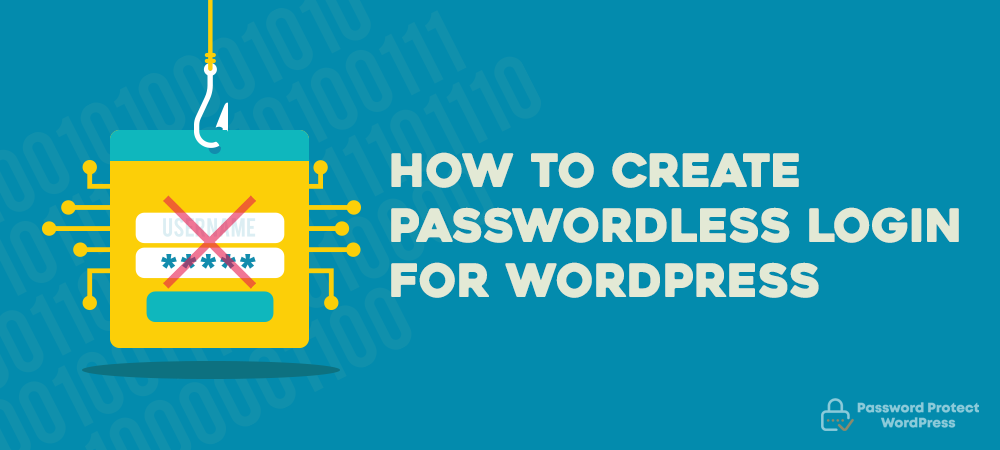Along with hosting companies and backups, passwords also play a vital role in every WordPress site’s security. Many people claim that enforcing users to create a strong and hard-to-guess password helps protect their sites from brute force attacks of bot or hackers. However, it’s not easy for users to set good passwords and keep track of them well.
Even though your users can create strong passwords and manage them efficiently, attackers still find ways to break passwords and log into your site. So how can you help your users escape the password hell and keep your site secure at the same time? Think about a passwordless login solution that provides users with access to your WordPress site automatically.
This article digs deep into explaining what passwordless login is and how to create passwordless logins for your WordPress site. Let’s get started with the basics.
What Is WordPress Passwordless Login?
WordPress passwordless login refers to alternative authentication methods that authorize users to access their WordPress account without entering passwords.
For instance, instead of filling in the account details in the login form, users will receive an email containing a link. They can click on that link and directly access your WordPress site with ease.
Common Problems with Passwords?
Before exploring how passwordless login works, we should understand the reasons why WordPress site owners prefer passwordless authentication. Here are the 4 most common problems with passwords that both site owners and users are facing.
#1 Users tend to set weak passwords when registering
When being asked for a password when registering, users likely think of easy-to-remember passwords like their birthday, their name, and some variations of the word “password” such as “passw0rd” or “p4ssw0rd”.
Avast (LSE: AVST), a global leader in online security products, claims in their online survey that 83% of Americans don’t follow strong password rules when creating passwords. Their passwords don’t contain more than 8 characters, uppercase and lowercase letters, numbers, and special characters like “!”, “$”, “?”. Consequently, hackers or bots can guess these passwords easily.
#2 Users set the same passwords for various accounts
Customers often use one password when signing up for different internet-based services such as bank accounts or e-commerce sites. Keeper Security company presents in its Mobile Survey Report that over 50% of American users reuse their passwords for multiple accounts.
Once hackers find out the password of an account, they can try it on other sites. This means you give them access to your whole digital life.
#3 Users may find it complicated to manage multiple accounts
Setting the same password for numerous accounts risks users’ credential security. As mentioned, once cybercriminals break the password of one of your accounts, they can attack others easily.
However, creating unique passwords for every account perhaps isn’t a better solution. Your users have to manage an endless variety of passwords for their numerous accounts.
What if they mistake this account’s password for others? It’s not ideal to try to remember passwords. However, resetting passwords can take a lot of time.
#4 Users often quit after a password reset
As mentioned, despite the password reset capability, 75% of users quit after a password reset once they forget the password, according to Snoop Two Factors.
Let’s take e-commerce stores as an example. What if your customers come back to your site to make new purchases but forget passwords and you require them to reset their passwords? They would rather go to another store than taking the time to recover or creating their passwords. As a consequence, you lose a loyal consumer.
Passwordless login comes in handy in these cases. Instead of letting users create weak passwords or reuse old ones for their WordPress accounts, you can help them bypass login pages effortlessly.
How Does Passwordless Login Work?
Passwordless login doesn’t mean that users are able to access your WordPress site without any identification. Instead of being verified via a password, they must verify their identities in different ways, depending on the passwordless login system you choose from. These systems include passwordless email authentication, token-based authentication, or biometric authentication.
Although these systems all function as a verificator to identify authorized users, each works a little differently.
#1 Passwordless email authentication
This is the most common passwordless authentication method, working similarly to a password reset. Instead of passwords, users receive an email acting as a login token.
Whenever users attempt to log into a WordPress website, they must enter their email addresses. After that, a magic link will be sent to their mailbox. He can click on the link and unlock the WordPress account.
#2 Token-based authentication
Similar to passwordless email authentication, token-based authentication uses emails to verify users. Users will enter their usernames and passwords to log in first. Then, they will receive a unique encrypted token allowing them to access other resources of the website automatically. Here is the process of this authentication system:
- A user provides his username and password in a login form.
- The server will generate a signed token for that user then send it back to his browsers.
- Once that user wants to access resources that require passwords or login information such as protected content or forums, he will be signed in automatically.
- Once the user logs out, the token will become invalid.
#3 Biometric authentication
Biometric authentication refers to a security process relying on the unique biological characteristics of an individual such as fingerprint or face to authenticate their identities. It’s applied mostly on smart mobile devices.
It’s quite simple to apply this passwordless login system. All users need to do involves pressing their fingerprints on or showing up their faces on the prompt appearing on their smartphones, for example.
However, biometric authentication isn’t entirely secure and not really popular in the WordPress niche. Since it identifies users based on their faces, people can use a photo to gain access to the devices.
How to Create WordPress Passwordless Logins
Passwordless Login plugin, as the name suggests, offers a great solution to allow logins into your WordPress site without the use of a password. Instead, it asks users for their usernames or emails to gain access to your WordPress website.

Upon installation and activation, the plugin will be inserted to your WordPress dashboard, under the Users section.
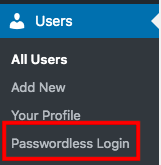
Follow these 3 simple steps to generate passwordless logins to your WordPress site:
- Copy the following shortcode on Passwordless Login settings page
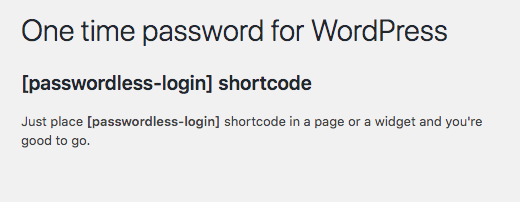
- Head to Widgets under Appearance
- Place the shortcode in the Content box of a Text Widget.
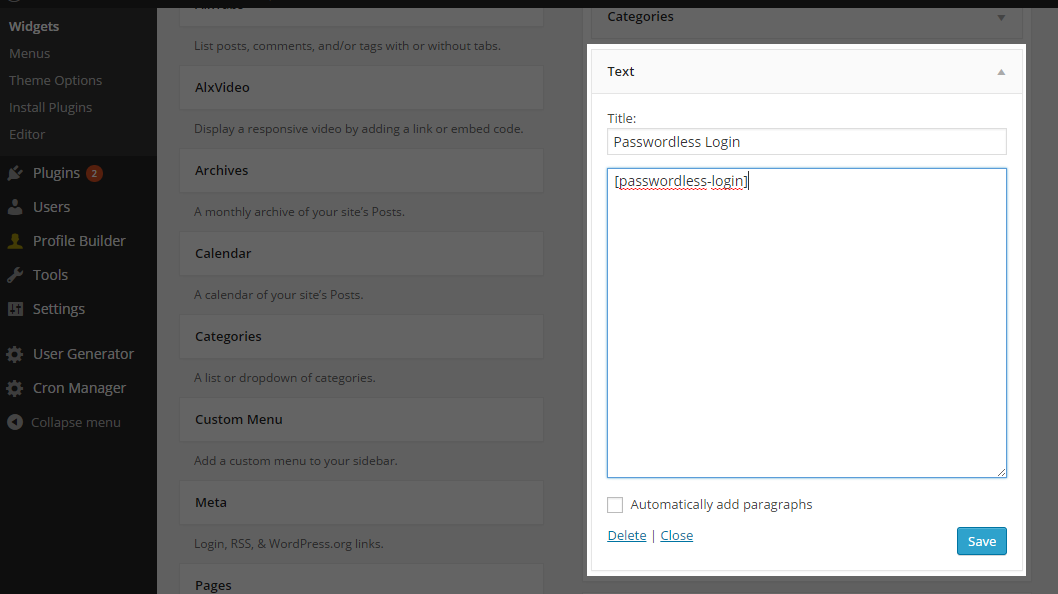
Only registered users with the correct email addresses or usernames are allowed to access your WordPress site without entering passwords later.

The plugin also generates a temporary authorization token which will expire after 10 minutes. It then sends the user an email with a link that contains the token.

Whenever the user clicks on the links, the plugin will verify the access token. They will successfully log into the WordPress site if the token is valid.
Bypass Password Protected Content
Password protected content refers to posts or pages locked by a password form. Only those who enter the correct password are able to open and view the content.
However, it’s possible for you to bypass this process by sending users a quick access link to unlock the protected content. In other words, they no longer have to enter passwords. Instead, they will click on the link sent to their email and go directly to the page.
To achieve this, you need support from the PPWP Pro plugin. It primarily enables you to set passwords for your WordPress content. You can also use it to generate quick access links for users to open the page without having to enter passwords.
Once installing and activating the plugin, follow 6 simple steps below:
- Head to Pages or Posts section in your WordPress admin dashboard
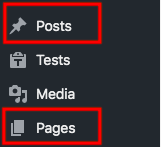
- Choose your desired page/post in the list
- Click “Password protect” and a password protection popup will show up

- Hit the “Password protect this page” lock icon
- Auto-generate new passwords or create your own one
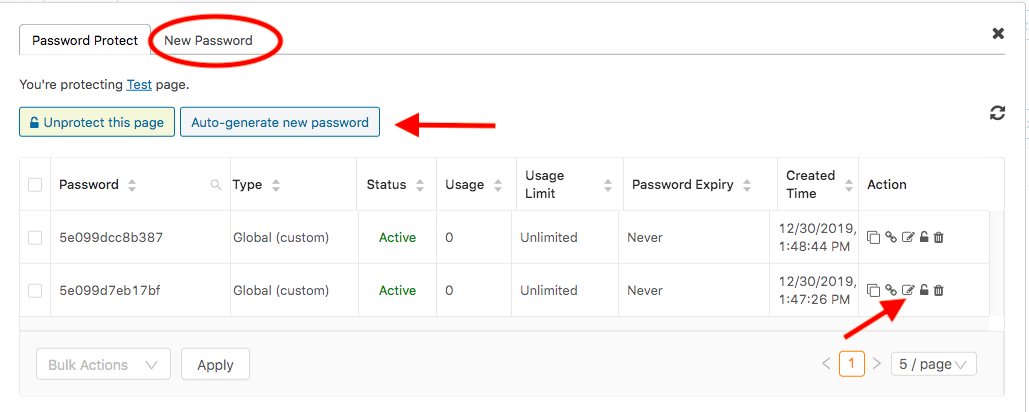
- Click on the access link icon of every password to copy the page’s quick access link. You can send this link to users via emails so that they can open the protected content effortlessly.

There are a few things you should notice in the password protection popup to make use of the plugin capabilities:
- You’re able to create as many passwords for a page/post as you’d love to. Each user can have his own password.
- Each password corresponds to a unique access link. If your post has 5 passwords, this means it has 5 access links.
- You can expire your passwords after a given time or a number of clicks by setting Usage Limit and Password Expiry.
- The quick access link expiration will follow its password’s rules.
Wrapping Up
Although passwords are a ubiquitous part of the digital age, there are still unknown problems you might face. If users create weak passwords, hackers can attack and obtain access to your site within seconds. In case you require users to use a strong and complex password, they may forget it and quit when being asked to reset the password.
It’s necessary to replace your WordPress passwords with other alternative authentication methods. Not only can users save time filling passwords in login forms, but you can also secure your site and prevent leaking passwords.
PPWP Pro makes it easy for you to let users access your protected content without having to enter the password. Simply set a password for the page, copy its quick access link, then send the link to users. That’s it!
Let our PPWP Pro plugin take the passwordless login authentication burden out of your shoulder now!
